

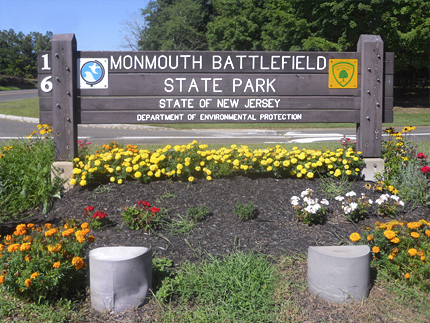
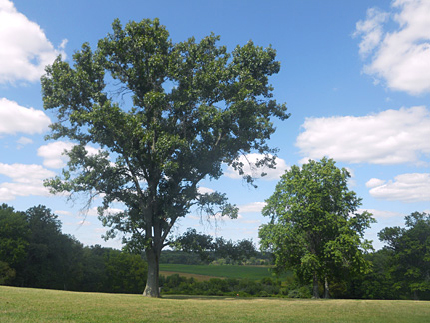
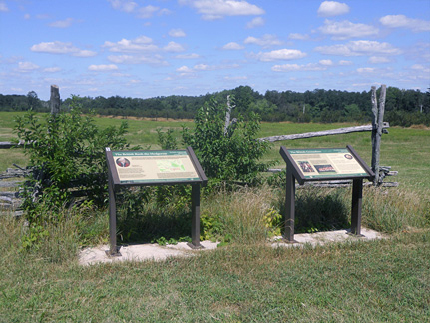
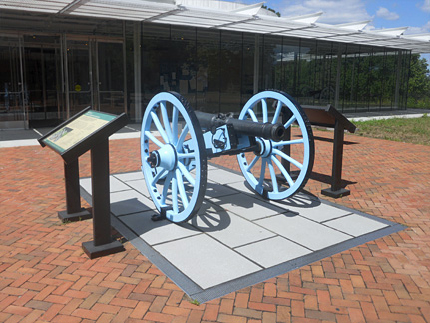
Monmouth Battlefield State Park
16 Business Route 33
Map / Directions to Monmouth Battlefield State Park
For current hours and admission information, see the
Monmouth Battlefield State Park web page
A Battle of Monmouth re-enactment is held at the park each June.
For more information, see the website of the Friends of Monmouth Battlefield, who cosponsor the event.
The Battle of Monmouth - June 28, 1778 [1]
The Battle of Monmouth was the longest continuous battle of the Revolutionary War. It took place here on a brutally hot summer day. How and why this important battle took place here involve events which began the previous autumn, with the British occupation of Philadelphia. Philadelphia had been serving as the American capital, and the British occupation forced Congress to move to York, Pennsylvania, which had a demoralizing effect on the Americans. British and Hessian forces occupied Philadelphia from September 26, 1777 until June 18, 1778. (Hessians were German mercenary soldiers hired by the British to fight on their side in the Revolutionary War.)
During that same winter of 1777, General George Washington and his Continental (American) army were encamped about twenty miles away from Philadelphia in Valley Forge, Pennsylvania. Valley Forge provided a good strategic location for the army's winter quarters: It was close enough to keep an eye on the British troops in Philadelphia, but in a strong defensive position should the British decide to attack.
In early June 1778, the British forces in Philadelphia decided to abandon the city and march towards New York City, the main British stronghold in America during the Revolutionary War. British forces under General Henry Clinton began their trip on June 18, 1778, when they crossed over the Delaware River into New Jersey, landing at Coopers Ferry (now Camden). Over the following days, they made their way northeast across New Jersey, marching through Haddonfield, Cherry Hill, Mount Laurel, Moorestown, Mount Holly, Bordentown, Crosswicks, and Upper Freehold.
During this time, General Washington and his Continental army were also on the move. After hearing of the British evacuation of Philadelphia, Washington made the decision to leave Valley Forge. On June 21-22, they crossed the Delaware River into New Jersey at Coryell's Ferry and marched in pursuit of the British troops, marching through Hopewell Borough, Mount Airy, Kingston, and Cranbury.
On June 26, the British stopped at an area of Freehold that was known as Monmouth Courthouse because the courthouse for Monmouth County was located there. They were still there on the morning of June 28.
Meanwhile, the Continental Army was miles away at Ponolopan Bridge in what is now Monroe Township. An advance force of 5,000 men under the command of General Charles Lee was sent towards Monmouth Courthouse. On June 27, Lee's forces were in Englishtown with orders from Washington to attack the British rear guard in Monmouth Courthouse the following morning if possible. [2]
The following morning, June 28, Lee's advance force did make the attack on the rear guard of the British forces at Monmouth Courthouse. The first shots of the Battle of Monmouth were fired about 10 a.m. about two miles east of park, by where the Monmouth Battle Monument now stands in Freehold.
Around noon, General Lee's forces retreated. However, when Lee was confronted by George Washington on the battlefield, Washington put a stop to the retreat and quickly organized a battle plan. (This incident led to an exchange of letters between the Generals Lee and Washington in the two days after the battle, which would in turn lead to General Lee's court-martial. See the Englishtown page for more information.)
From about 1 pm to about 6 pm, the fighting was continuous, and took place mainly on the grounds of what is now the park. The battle raged across these fields in temperatures around 100°. Joseph Plumb Martin, who was a private in the Continental Army in the Battle of Monmouth, later wrote of fighting in the terrible heat of that day: [3]
"The sun shining full upon the field, the soil of which was sandy, the mouth of a heated oven seemed to me to be but a trifle hotter than this ploughed field; it was almost impossible to breathe... I presume everyone has heard of the heat of that day, but none can realize it that did not feel it. Fighting is hot work in cool weather, how much more so in such weather as it was on the twenty-eighth of June, 1778."
After the fighting ended for the day, Washington planned to resume the battle In the morning, but the British forces silently withdrew during the night, continuing their march towards New York City. They marched through Middletown, where they awaited transportation by boats from Sandy Hook to New York City.

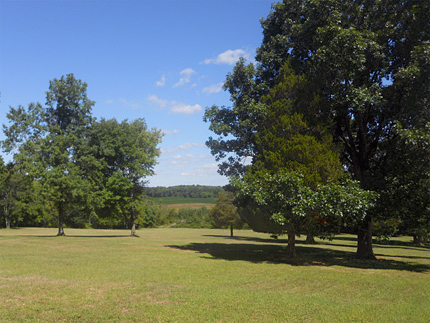
Exploring The Park
Monmouth Battlefield State Park is a 1,818-acre park which includes much of the area where the Battle of Monmouth was fought. [4]
Those who are interested in learning more about the fighting as it unfolded throughout the day of June 28, 1778, are recommended to visit the Park. The Visitors Center has many exhibits to explain the battle. From there, you can explore the grounds yourself by taking a walk around the battlefield, supplied with trail maps available at the visitors center. The plaques placed throughout the trails further help in understanding.
Some of the notable features of the park are detailed below.

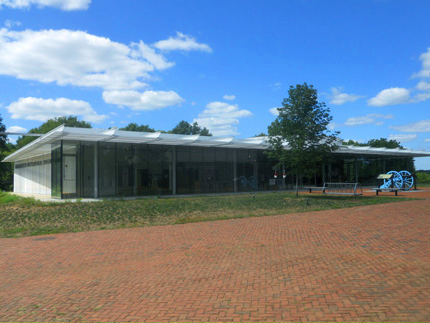
Visitors Center
The best place to begin your visit to the park is the Visitors Center. It contains exhibits about the Battle of Monmouth and the Revolutionary War which help to put it in context.
The Visitors Center contains a small theatre which shows a ten-minute film about the battle throughout the day.
One of the most helpful exhibits is a three-dimensional map of the area which presents a thirteen-minute, audio-visual presentation of the Battle of Monmouth. It combines narration with lights on the map which represent the movement of troops across the terrain of the area, which helps the viewer to understand the movement of troops across the fields. Viewing this presentation before exploring the park's trails is highly recommended.
The Visitors Center also contains a gift shop.

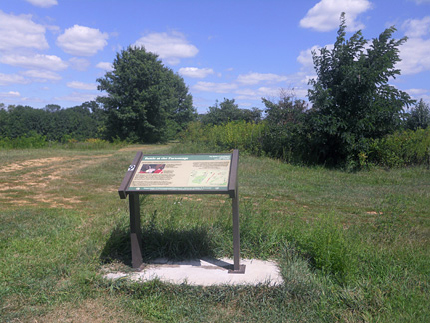
Trails and Interpretive Plaques
The park contains twenty-five miles of trails to explore the area where the Battle of Monmouth occurred.
Maps of the paths, and brochures to explain the hikes, can be obtained at the Visitors Center. Some of the trails are as short as half a mile and some are several miles, so you can plan your hike depending on your time and how much walking you would like to do.
Along the paths there are interpretive plaques which explain the events that occurred here. The plaques include some which focus on particulars of the battle in specific locations. Others focus on such topics as George Washington as a leader, battlefield archeology, and the story of Molly Pitcher.

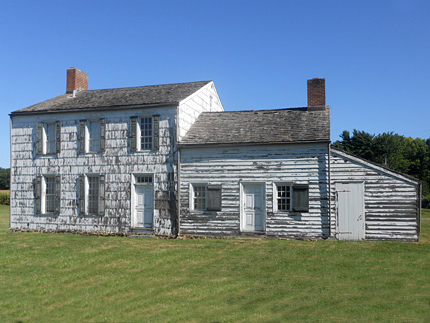
Craig House
This house was the home of John and Ann Craig at the time of the Battle of Monmouth.
The Craig House is open for limited hours.
Contact the Visitors Center to check on when the Craig House will be open for tours.
John Craig, who served in the Revolutionary War, is buried alongside Ann at the nearby Old Tennent Church Cemetery. (See the Old Tennent Church and Cemetery entry below on this page.) [5]

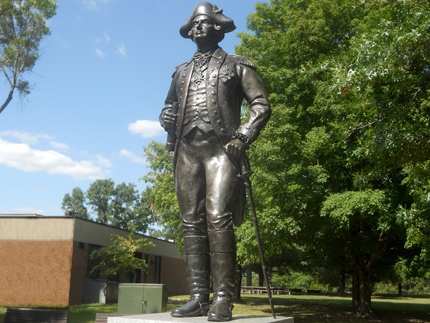
General von Steuben was a Prussian military officer who came to America to fight on the American side in the Revolutionary War. In early 1778, von Steuben came to the Continental Army's winter encampment at Valley Forge, PA, where he instituted a system of training which would contribute greatly to the improvement of the army, and to their success at the Battle of Monmouth. A plaque on the base of the statue describes: [6]
"Even in the face of desperate conditions, including frost, disease, inadequate shelter and lack of supplies, von Steuben gave military training and discipline to the citizen soldiers fighting for American independence. In May 1778, Congress approved General Washington’s recommendation to appoint von Steuben as Inspector General of the Continental Army.
"On June 28, 1778, at the Battle of Monmouth, the benefits of von Steuben’s training were evidenced by the American troops opposing the British Army. The heroic American performance, a turn in the tide of the war, is attributed in large part to the work of von Steuben."


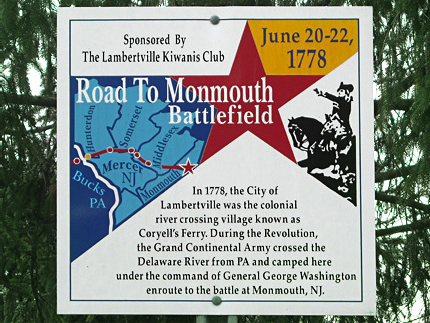
Roads to and from the Battle of Monmouth
For those wishing to explore the routes taken to and from the battle by the Continental, British and Hessian forces, there are many locations associated with these marches in New Jersey. This website details many such locations.
Locations associated with the Continental Army's march to the Battle of Monmouth can be found in Lambertville, Mount Airy, Hopewell Borough, Kingston, Cranbury. and Englishtown.
Locations associated with the march of British and Hessian troops prior to the Battle of Monmouth can be found in Camden, Haddonfield, Cherry Hill, Mount Laurel, Moorestown, Mount Holly, Bordentown, Crosswicks, and Upper Freehold. Sites associated with their retreat after the battle can be found in Middletown and Sandy Hook.
The sign pictured at left is located in Lambertville.


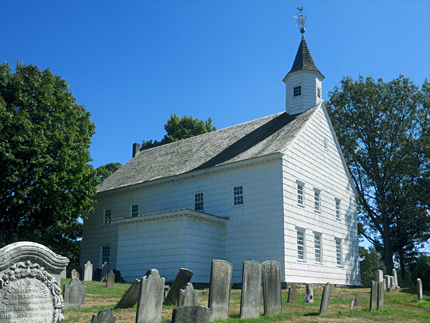
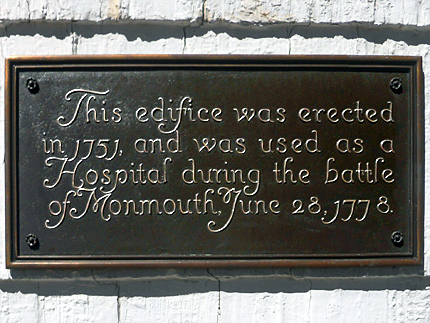
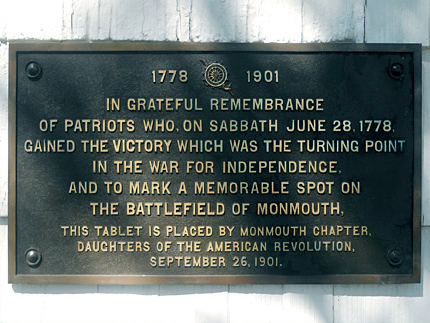
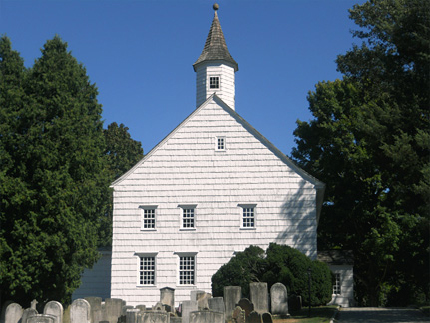
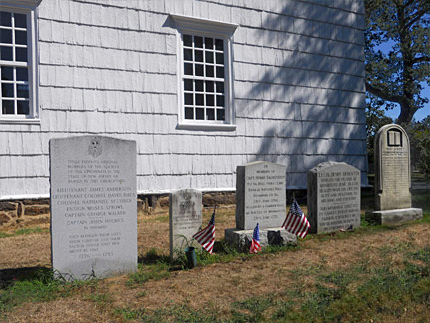
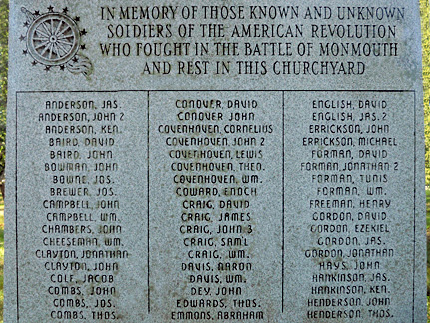
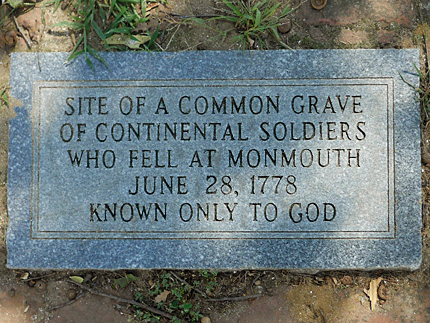
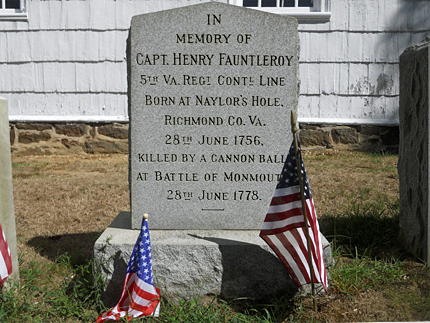
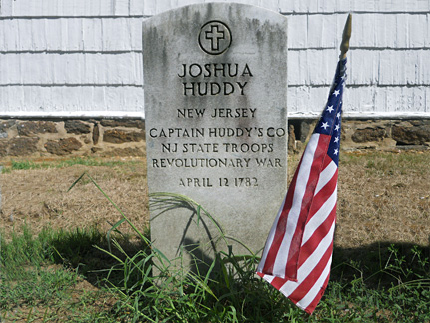
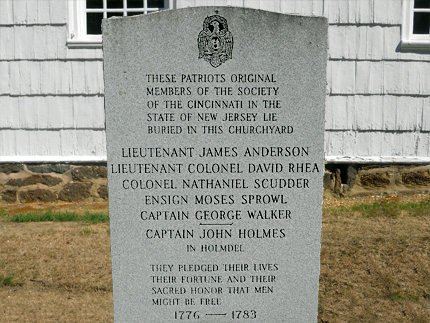
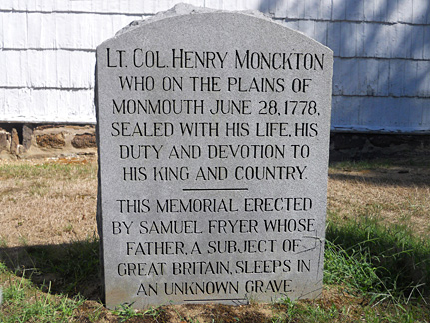
Old Tennent Church & Cemetery
448 Tennent Rd.
Map / Directions to Old Tennent Church
For more information about the church's history, see the church website:
https://www.facebook.com/oldtennentchurch/
Old Tennent Church
The Old Tennent Church has a long and rich history. Built in 1751, it was already twenty-seven years old when the Battle of Monmouth occurred. The church was hit by cannon balls during the battle. Afterward, it was used as a hospital for wounded American soldiers. These events left physical evidence on the church building and grounds. Much of the damage has been repaired over the years for preservation of the building. Some of the pews still bear the marks of surgeon's saws and blood from when the building was used as a hospital. [7]
The Cemetery [8]
The church's cemetery contains the graves of over seventy known Revolutionary War veterans, as well as a common grave of American soldiers who died at the Battle of Monmouth. The number and identities of the men buried in the common grave are unknown.
Among the graves is Nathaniel Scudder, who in addition to serving as a colonel in the New Jersey militia also played an important political role during the Revolutionary War era. He served in the Provincial Congress of New Jersey, as the speaker of the New Jersey general assembly and the in the Continental Congress. He was one of two New Jersey signers of the Articles of Confederation. [9] (The other signer was John Witherspoon.)
Another notable grave is that of Joshua Huddy. For an account of Huddy's interesting story, which includes his capture, escape, recapture and eventual hanging by the British, see the entry for his homestead in Colts Neck. There is a stone to Huddy's memory next to the church, although the exact location where he is buried in the graveyard is unknown.
There are also British soldiers buried in the cemetery, including Lt. Colonel Henry Monckton, who was the highest ranking British officer killed during the Battle of Monmouth.
The following Revolutionary War soldiers are known to be buried in the cemetery: [10]
James Anderson
John Anderson *
John Anderson *
Ken Anderson
David Baird
John Baird
John Bowman
Joseph Bowne
Joseph Brewer
John Campbell
William Campbell
John Chambers
William Cheeseman
Jonathan Clayton
John Clayton
Jacob Cole
John Combs
Joseph Combs
Thomas Combs
David Conover
John Conover
Cornelius Covenhoven
John Covenhoven *
John Covenhoven *
Lewis Covenhoven
Theodore Covenhoven
William Covenhoven
Enoch Coward
David Craig
James Craig
John Craig *
John Craig *
John Craig *
Samuel Craig
William Craig
Aaron Davis
William Davis
John Dey
Thomas Edwards
Abraham Emmons
David English
James English *
James English *
John Errickson
Michael Errickson
Henry Fauntleroy
David Forman
Jonathan Forman *
Jonathan Forman *
Tunis Forman
William Forman
Henry Freeman
David Gordon
Ezekiel Gordon
James Gordon
Jonathan Gordon
John Hays
James Hankinson
Ken Hankinson
John Henderson
Thomas Henderson
William Henderson
Daniel Herbert
James Herbert
Joshua Huddy
William Johnson
Peter Johnston
William Johnston
Moses Laird
Richard Laird
William Laird *
William Laird *
Samuel Leonard
John Lloyd
Alex Low
James McChesney
Robert McChesney
William McDermott
Joseph McKnight
Matthew Mount
Hugh Newell
Thomas Parker
John Perrine
Lewis Perrine
Matthew Perrine
John Reed
Aaron Reid
David Rhea
John Rogers
Samuel Rogers
John Rue
Joseph Scudder
Nathaniel Scudder
Ruliff Schenck
Stephen Seabrooks
Thomas Smith
Moses Sproule
Derrick Sutphen
John Sutphen
Joseph Sutphen
Jacob Suydam
Joseph Thompson
William Tone
Benjamin Van Cleve
John Vanderveer
John Voorhees
Aaron Walker
George Walker
Elisha Walton
Thomas West
Jacob Wickoff
William Wikoff
Joseph Wilson
Reverend John Woodhull
James Yetman
John Yetman
* The soldiers listed with duplicate names are not typos. In these cases, two or three veterans with the same name are buried in this cemetery

1. ^ The sources consulted for this entry include:
~ Proceedings of a General Court Martial, Held at Brunswick, in the State of New-Jersey, by order of his Excellency General Washington, Commander in Chief of the Army of the United States of America for the Trial of Major General Lee, July 4th, 1778 (Philadelphia: John Dunlap, 1778)
reprinted in Collections of the New York Historical Society for the Year 1873 (New York: 1874) pages 6-7
Available to be read at the Internet Archive here~ Joseph Plumb Martin, Edited by George F. Scheer, Private Yankee Doodle (Eastern National; 2012 Edition)
~ Samuel Stelle Smith, The Battle of Monmouth (Monmouth Beach, NJ: Phillip Freneau Press, 1964) pages 6-11
~ Samuel Stelle Smith, The Battle of Monmouth (# 25 in the New Jersey's Revolutionary Experience series) (Trenton: New Jersey Historical Commission, 1975/1978) pages 8-10
~ “From George Washington to Henry Laurens, 1 July 1778,” Founders Online, National Archives (http://founders.archives.gov/documents/Washington/03-16-02-0003 [last update: 2015-09-29]). Source: The Papers of George Washington, Revolutionary War Series, vol. 16, 1 July–14 September 1778, ed. David R. Hoth. Charlottesville: University of Virginia Press, 2006, pp. 2–7.
~ William S. Stryker, The Battle of Monmouth (Port Washington, NY, London: Kennikat Press, 1970 reissue of the work originally published in 1927)
~ Exhibits and historic plaques at Monmouth Battlefield Historic Park and the Visitors Center
~ Various letters from the time period, many available at the Founders Online, National Archives website
•For more information and accompanying source notes about the towns which were marched through before the Battle of Monmouth, see the town pages linked from within the text.
• For information about visiting the site of the Continental Army's 1778-1779 encampment at Valley Forge, Pennsylvania, see the Valley Forge National Historical Park section of the National Park Service website.
• Figures for troop strength and casualties for the Battle of Monmouth vary considerably in different sources. The following figures are posted on a display inside the Monmouth Battlefield State Park Visitors Center.
Continental Army
Under the command of General George Washington
14,436 - Troop Strength
69 Killed
162 Wounded
132 Missing
363 Total CasualtiesBritish Army (including Hessian and Loyalist forces)
Under the command of General Henry Clinton
20,120 - Troop Strength67 Killed
59 Heat-stroke
170 Wounded
65 Missing
361 CasualtiesThe display states, "Please note that the numbers displayed above are estimates only, as different sources sometimes provide conflicting information."
• Although this display does not list heatstroke numbers for the Continental Army, there were Continental soldiers who died from the heat during the battle. In General Washington's letter to the Congress about the Battle of Monmouth, he mentions that several of his soldiers died from heat.
Washington's letter can be read at the National Archives website:
“From George Washington to Henry Laurens, 1 July 1778,” Founders Online, National Archives (http://founders.archives.gov/documents/Washington/03-16-02-0003 [last update: 2015-09-29]). Source: The Papers of George Washington, Revolutionary War Series, vol. 16, 1 July–14 September 1778, ed. David R. Hoth. Charlottesville: University of Virginia Press, 2006, pp. 2–7.2. ^ Washington's orders to Lee on the afternoon of June 27 were made verbally. Washington's letter to Congress written the following morning states, "We have a select and strong detachment more forward under the general command of Major Genl Lee, with orders to attack their rear if possible."
The letter is available to be read at the National Archives website:
“From George Washington to Henry Laurens, 28 June 1778,” Founders Online, National Archives (http://founders.archives.gov/documents/Washington/03-15-02-0620 [last update: 2015-09-29]). Source: The Papers of George Washington, Revolutionary War Series, vol. 15, May–June 1778, ed. Edward G. Lengel. Charlottesville: University of Virginia Press, 2006, pp. 578–579.
3. ^ Joseph Plumb Martin, Edited by George F. Scheer, Private Yankee Doodle (Eastern National: 2012 Edition) pages 127 and 131
4. ^ The 1,818 acre figure is from the New Jersey Department of Environmental Protection webpage for Monmouth Battlefield State Park. Information about the park's features such the Visitor Center and the trails was drawn from personal visits to the park.
5. ^ Gravestones at the Old Tennent Church
6. ^ Erected 2004 by the Steuben Society of America and the Friends of Monmouth Battlefield
7. ^ History page of the Old Tennent Church website
8. ^ Information about the cemetery was drawn from gravestones and markers in the cemetery, and the A Walk Through Old Tennent Cemetery article on the Old Tennent Church website.
9. ^ Biographical Directory of the United States Congress
10. ^ The list of names of American Revolutionary War soldiers buried here was drawn from a stone erected by the Tennent Chapter of the Daughters of the American Revolution. Henry Fauntleroy's name does not appear on the list on that stone, but his gravestone stands near the church building. (Photo appears above)